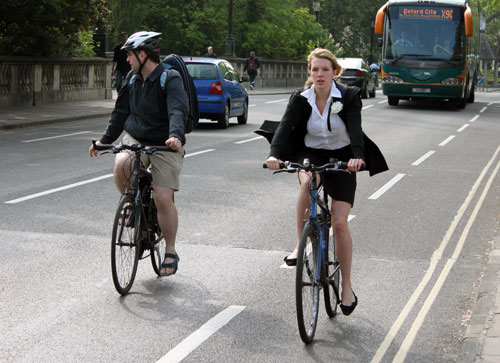
(tentatively getting into position for right hand lane.)
Taking photos of cyclists at Magdalen Bridge, I was observing how people were cycling. Also many cyclists need to move across into the right hand lane in order to be able to turn right.
It is potentially tricky because you can have buses and vans going straight across, so you have to be careful when moving into outside lane.
There are certain things that make this manoeuvre more manageable for cyclists on this particular road.
- Safety in Numbers. As you can see from the photos, there are more bikes than vehicles. Cyclists get confidence from seeing other people on the bike, but more importantly other road users are expecting cyclists on the road; therefore as much as is possible, cyclists are tolerated. I didn’t witness any beeping of horns or any incident during this photo shoot. (It tends to be worse going the other way to Magdalen roundabout when for some reason buses tend to be travelling faster.)
- 20mph Speed Limit. Though it is dubious whether 20mph speed limits are actually enforced. On this stretch of the road, traffic does seem to be going at a reasonable speed. I feel part of the reason cars stick to the speed limit is because they are aware of the presence of so many cyclists on road. The road is certainly not conducive to speeding over 20mph. – When you are turning right across a lane of traffic, there is a huge difference between traffic travelling at 20mph and traffic travelling at 30mph. Obviously when traffic is moving at speeds closer to cyclists it is much easier to judge and find spaces to move across. This is a good reason for 20mph zones in cities, it definitely makes cycling safer.
- Cars banned on High Street. Oxford high street is a very beautiful street, it is also one of the main thoroughfares into town. A few years ago, cars were banned (during the day) from driving through the street. It means when driving, you have to follow a one way system around the town. Overall, I think it is an excellent scheme for Oxford in encouraging people to find alternative methods of transport where possible. High Street is far from being a cyclist heaven because of the huge volume of large buses, but, the idea of car free areas are potentially very good.
What A Cyclist needs to Do When Turning Right

Despite a relatively good situation for cyclists, it is still potentially dangerous. There is always a danger of becoming over-confident and forgetting the basics. This is the key to surviving a right turn.
- Look Over Shoulder. It is essential to see what is coming past. Most cyclists were doing this. But, you do see the odd cyclist who moves out without looking at all. Some signal right and then move out into the right lane, but, never look. Both are essential.
- Signal. When there is a reasonable gap, signal right and only when you have seen cars slow down or acknowledge your choice, move out.
- Eye Contact. It is important to check the driver has acknowledged your decision. Just because you look over your shoulder and signal doesn’t mean every driver will allow you to move out. It may not be necessary to see the white of the eyes, when they slow down is a sign they have seen.
- Be Reasonable. You shouldn’t move out, if it requires a driver to slow down in a short space of time. At the same time, it is important to be confident of your right to move into the outside hand lane. Once you have seen it is safe cycle across and claim the lane if necessary.
Warning – Squeezing Down Left of buses. One of the most dangerous manoeuvres for cyclists is squeezing down the left hand side of large vehicles. At least in the right hand lane, you know every vehicle has to turn right.
Related

hey great post! Have had many a problem turning right but never wanted to admit it. Quite refreshing